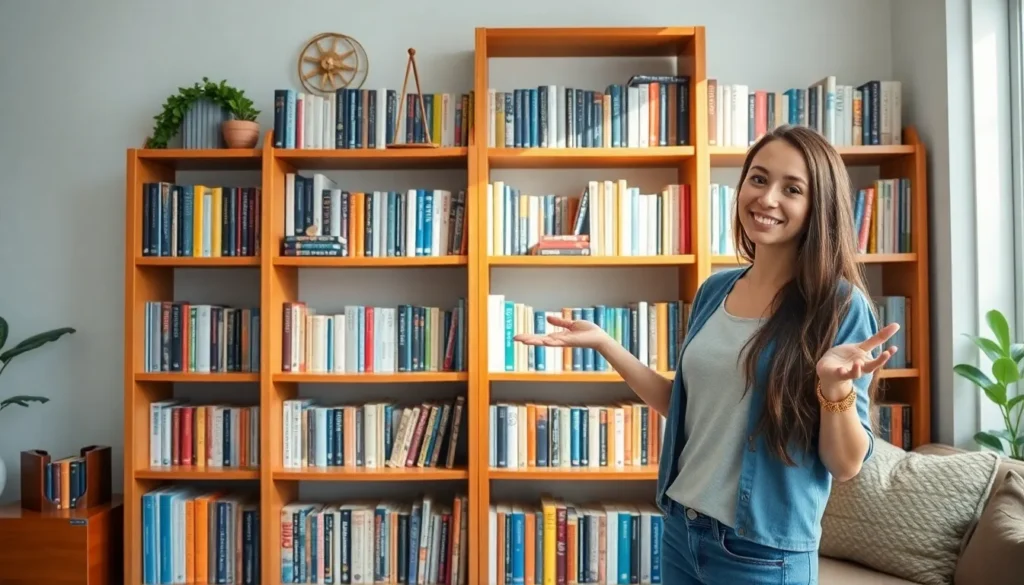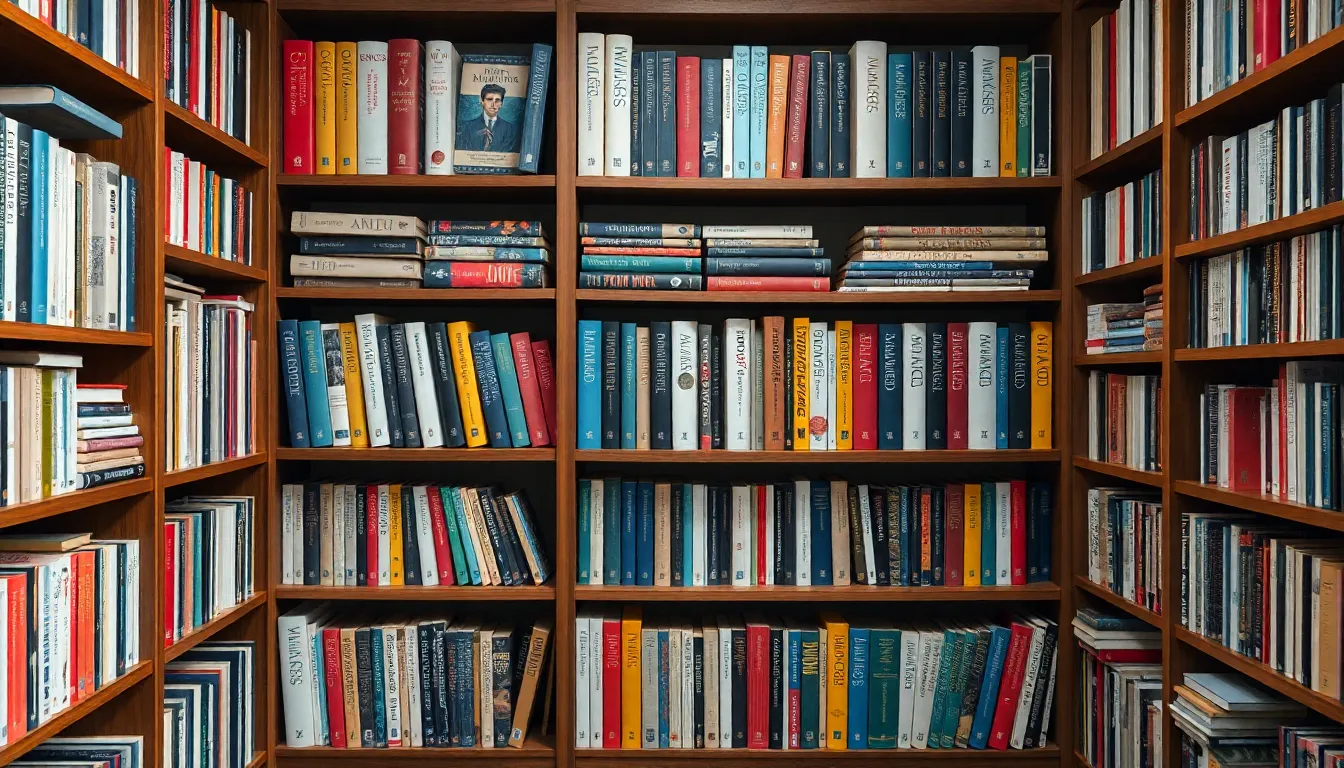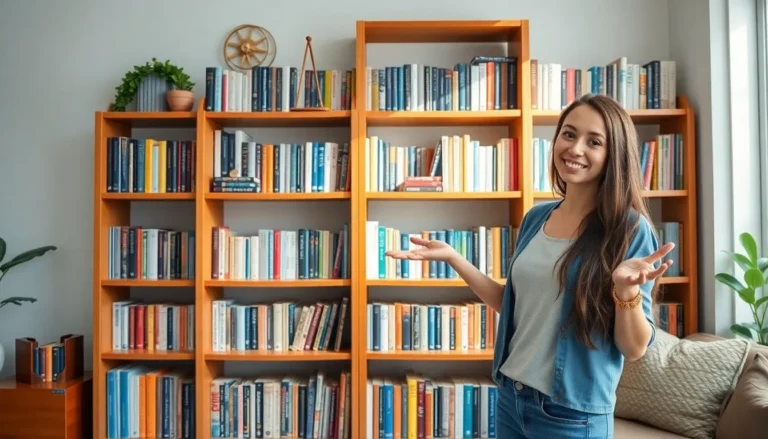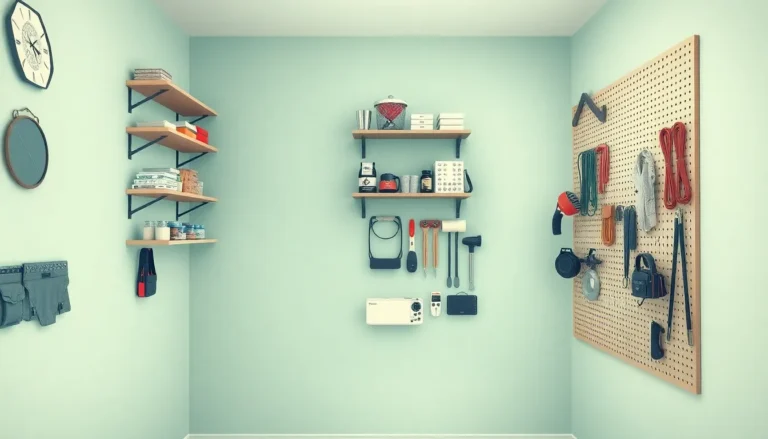Table of Contents
ToggleEver stared at your bookcase and thought it resembled a chaotic game of Tetris? You’re not alone. The struggle of organizing books can feel like an uphill battle, especially when every title seems to have a mind of its own. But fear not! Sorting methods are here to save the day, transforming that literary jungle into a well-ordered oasis.
Overview of Bookcase Sorting Methods
Sorting books can enhance both aesthetics and accessibility in a bookcase. Various methods exist to organize these collections, each suited to different needs and preferences.
Alphabetical Sorting organizes books by author or title, making it easy to locate specific titles. This method works well for libraries and personal collections with a wide variety of genres.
Genre Classification involves grouping books by subject matter. Fiction, non-fiction, mystery, science fiction, and romance are common categories. This method aids readers in quickly finding books that match their interests.
Chronological Order sorts books based on publication date. This approach highlights an author’s growth or thematic evolution over time. It can be especially useful for historians or those studying an author’s work.
Color Coordination arranges books according to their cover colors. This visually appealing method adds a decorative element to a space. While it may not enhance functionality, it can create a cohesive look.
Size and Format Sorting focuses on the dimensions of books. Grouping by height or format—such as hardcover, paperback, or digital—is practical for maximizing shelf space. This method can prevent overcrowding on shelves.
Reading Status keeps track of books that have been read, are currently reading, or are still to be read. This personal categorization helps prioritize reading goals. Each individual can tweak this method to fit their reading habits.
Exploring these sorting methods offers a pathway to an organized bookcase. Different methods cater to various priorities. He or she can select the most effective approach for their unique collection.
Popular Bookcase Sorting Methods
Book lovers can greatly benefit from different bookcase sorting methods. Here’s a closer look at effective strategies for organizing a collection.
Alphabetical Sorting
Alphabetical sorting organizes books by the author’s last name or the book title. This method simplifies finding specific titles, making retrieval quick. Libraries and bookstores commonly use this system, providing a familiar framework. Individuals who frequently reference particular authors or series may prefer this method. It’s straightforward and highly effective for those with extensive collections. Always ensure the correct spelling of names or titles to maintain organization.
Genre-Based Sorting
Genre-based sorting groups books according to their subject matter. This approach caters to readers’ interests, making it easy to locate specific genres. For instance, fiction, non-fiction, mystery, and fantasy can form distinct sections. Readers who prioritize particular genres often find this method enhances their reading experience. It allows quick access to desired shelves when searching for the next read. Labeling shelves can further improve efficiency in locating books.
Color-Coded Sorting
Color-coded sorting arranges books by cover color, creating a visually striking display. This method may appeal to those who appreciate aesthetics alongside practicality. While it enhances visual appeal, functionality can sometimes be overlooked. Readers may find it difficult to locate specific titles when relying solely on color. Despite this challenge, many enjoy the creative aspect of color coordination. It’s possible to implement a secondary sorting method alongside this approach for increased efficiency.
Size-Based Sorting
Size-based sorting focuses on the dimensions of books to maximize shelf space. Organizing books from tallest to shortest can promote a neat appearance while preventing overcrowding. This method suits collectors with diverse book sizes, avoiding clutter on shelves. Readers who want to create uniformity in their displays frequently adopt this strategy. Prioritizing this approach allows for better visibility and accessibility of all titles. Shelves can then accommodate larger books without overwhelming smaller ones.
Benefits of Effective Bookcase Sorting
Effective bookcase sorting enhances both aesthetics and functionality. It creates a visually appealing space, which encourages reading and appreciation of books. Organized collections ensure easy access, allowing individuals to quickly find desired titles without frustration.
Time management benefits arise from systematic sorting. When books are categorized, locating specific titles or genres takes less time, freeing up more time for reading. This efficiency leads to an improved reading experience and an increased likelihood of completing books.
Users gain a sense of accomplishment from a well-organized bookcase. The neatness promotes a calming environment, which fosters focus during reading sessions. An attractive display can also impress guests, showcasing personal taste and interests.
Maximized shelf space results from thoughtful organization. By leveraging size and format sorting, individuals prevent overcrowding, allowing for easier visibility of titles. This method further protects books from damage, preserving their condition for future readers.
In addition to physical benefits, sorted collections facilitate tracking reading status. Readers can visually prioritize books they intend to read next based on previously established categories. This structure encourages a more structured approach to reading.
Lastly, effective sorting methods can enhance the personal connection to a collection. As individuals reflect on their unique interests and preferences, the organization process itself becomes rewarding. Ultimately, implementing these sorting techniques transforms clutter into a curated collection, enriching the reading experience.
Tips for Implementing Bookcase Sorting Methods
Selecting an appropriate sorting method enhances both organization and accessibility. Alphabetical sorting serves many well, especially in libraries and bookstores. Genre classification can significantly aid readers in locating titles that match their interests, so consider labeling shelves for added clarity.
Chronological order proves beneficial for understanding an author’s evolution through their work. Color coordination adds a visual touch, while combining this method with another can optimize functionality. Sorting by size and format effectively maximizes shelf space, ensuring titles are visible and neatly arranged.
Tracking the reading status of books helps prioritize what to read next. Creating designated areas for completed, in-progress, and future reads simplifies decision-making. For individuals with larger collections, using a combination of these methods may yield the best results.
Consistency in the sorting method chosen promotes a sense of order. Regularly reviewing and adjusting the organization prevents clutter from reoccurring. Encouraging guests to contribute suggestions can also provide fresh perspectives on the arrangement.
Utilizing bookends or decorative boxes can further enhance organization, adding both style and functionality. Ensuring each book has a dedicated spot creates an inviting atmosphere that encourages reading. Regular maintenance of the system simplifies the experience, making it easier to keep the collection in top shape.
Being mindful of personal preferences allows for customization of the sorting approach. Tailoring the method to individual habits makes maintaining organization simpler. Ultimately, these careful considerations lead to an organized, aesthetically pleasing bookcase that reflects taste and promotes an engaging reading environment.
Conclusion
Organizing a bookcase doesn’t have to be a daunting task. By selecting the right sorting method tailored to individual preferences and needs, anyone can create an inviting and functional space. Whether it’s through alphabetical order genre classification or a blend of techniques, the goal remains the same: enhancing accessibility and aesthetics.
A well-sorted bookcase not only showcases personal style but also fosters a more enjoyable reading experience. Regularly revisiting and adjusting the organization ensures that the collection remains clutter-free and engaging. Ultimately, the right approach transforms a chaotic shelf into a curated collection that reflects one’s love for books.








